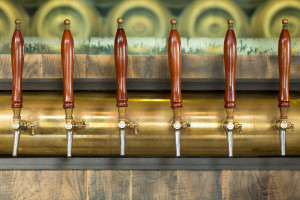 If you’ve ever been to a good party, you know that all you needed is a chilled keg, a beer tap and a red solo cup, and you’ll be sure to have a good time. However, at your local classy bar, the system is actually a bit more complicated than that. The keg-tap-solo cup system works well for a frat boy looking for his third buzz of the weekend, but a good beer system will include a high powered and reliable beer pump. Over the next two blogs, we’ll take a look at how beer pumps work and beer pump best practices for establishments of quality.
If you’ve ever been to a good party, you know that all you needed is a chilled keg, a beer tap and a red solo cup, and you’ll be sure to have a good time. However, at your local classy bar, the system is actually a bit more complicated than that. The keg-tap-solo cup system works well for a frat boy looking for his third buzz of the weekend, but a good beer system will include a high powered and reliable beer pump. Over the next two blogs, we’ll take a look at how beer pumps work and beer pump best practices for establishments of quality.
Beer Pump Basics
The basic purpose of the beer pump is to move beer from the keg or other container to the faucet. This is an alternative to using gas pressure to move the beer. Instead the pump uses mechanical force to deliver the beer to the faucet. It is common to find beers pumps in beer line systems where more than 35 or 40 psi is needed to create a consistent flow. Often, runs of more than 200 feet or set ups which require a significant vertical lift. If gas pressure is used above and beyond these pressures, it will create problems as the beer begins to absorb the gas and its composition will be altered, affecting the taste and quality. Some multi-barrel serving tanks which have low pressure limits also use beer pumps.
How Beer Pumps Work
Beer pumps themselves are powered by high-pressure gas or compressed air that does not come into contact with the beer. Most retailers power their beer pumps with CO2 ; in these cases, the pump exhaust CO2 gas must be vented outside the cooler or building to avoid CO2 buildup and asphyxiation. CO2 can be relatively expensive to use to power beer pumps compared to compressed air, but CO2 is usually already available at any location serving draught beer, so is often simpler to use.
Compressed Air
If a system uses compressed, the air should never contact the draught beer. Additionally, it is best to use a high quality air compressor. These can clean and dry the air to avoid damaging beer pumps. Cheaper, smaller, air compressors often deliver air which still contain small amounts of moisture and oil that can cause damage to the beer pump eventually. If the compressor breaks, the establishment will be unable to serve beer.
Fixed and Additive Pressure
Beer pumps essentially come in two basic types: fixed pressure and additive pressure. It is growing harder and harder to find a fixed pressure pump. This is because a fixed pressure pump only delivers beer at the same pressure which is being applied to the keg. An additive pressure pump is usually found in long draw systems, because keg’s applied pressure is in addition to the gas pressure which moves beer through the pump. Finally, an additive pressure system can still pump beer however weakly, if it fails, which is something a fixed system cannot do.
Of course, a portion of the pump comes in contact with the beer and (like anything else) should be cleaned regularly to guard against build up and germs. If you need more help understanding beer pumps or other components of the draft beer line system, please contact us at Clean Beer, in Milford, MA. We can meet all your beer line needs, from installation to cleaning and maintenance. In addition to our services, we sell new and used beer line equipment, for your home or bar. Clean Beer is the home of the clean beer line experts, contact us about your home or commercial tap needs.
